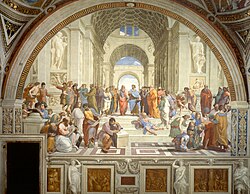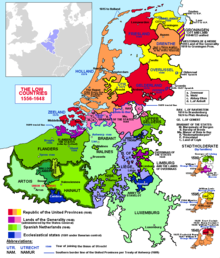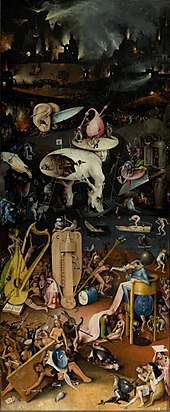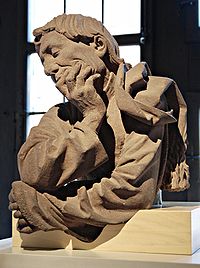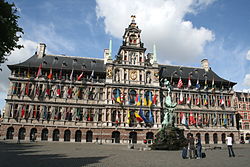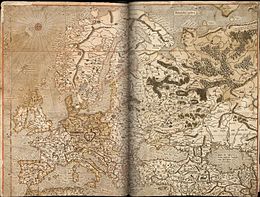
Pieter Bruegelthe Elder was among the most significant artists of Dutch and Flemish Renaissance painting, a painter and printmaker, known for his landscapes and peasant scenes ; he was a pioneer in presenting both types of subject as large paintings.

Jan Brueghelthe Elder was a Flemish painter and draughtsman. He was the son of the eminent Flemish Renaissance painter Pieter Bruegel the Elder. A close friend and frequent collaborator with Peter Paul Rubens, the two artists were the leading Flemish painters in the first three decades of the 17th century.
The designation Franco-Flemish School, also called Netherlandish School, Burgundian School, Low Countries School, Flemish School, Dutch School, or Northern School, refers to the style of polyphonic vocal music composition originating from France and from the Burgundian Netherlands in the 15th and 16th centuries as well as to the composers who wrote it. The spread of their technique, especially after the revolutionary development of printing, produced the first true international style since the unification of Gregorian chant in the 9th century. Franco-Flemish composers mainly wrote sacred music, primarily masses, motets, and hymns.
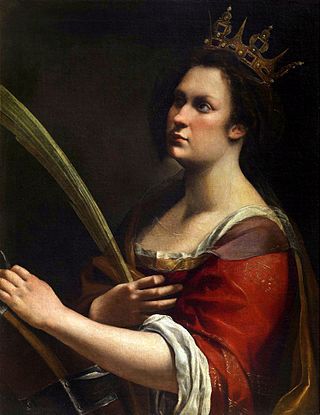
In art history, "Old Master" refers to any painter of skill who worked in Europe before about 1800, or a painting by such an artist. An "old master print" is an original print made by an artist in the same period. The term "old master drawing" is used in the same way.

Early Netherlandish painting is the body of work by artists active in the Burgundian and Habsburg Netherlands during the 15th- and 16th-century Northern Renaissance period, once known as the Flemish Primitives. It flourished especially in the cities of Bruges, Ghent, Mechelen, Leuven, Tournai and Brussels, all in present-day Belgium. The period begins approximately with Robert Campin and Jan van Eyck in the 1420s and lasts at least until the death of Gerard David in 1523, although many scholars extend it to the start of the Dutch Revolt in 1566 or 1568–Max J. Friedländer's acclaimed surveys run through Pieter Bruegel the Elder. Early Netherlandish painting coincides with the Early and High Italian Renaissance, but the early period is seen as an independent artistic evolution, separate from the Renaissance humanism that characterised developments in Italy. Beginning in the 1490s, as increasing numbers of Netherlandish and other Northern painters traveled to Italy, Renaissance ideals and painting styles were incorporated into northern painting. As a result, Early Netherlandish painters are often categorised as belonging to both the Northern Renaissance and the Late or International Gothic.
Michiel Coxie the Elder, Michiel Coxcie the Elder or Michiel van Coxcie, Latinised name Coxius, was a Flemish painter of altarpieces and portraits, a draughtsman and a designer of stained-glass windows, tapestries and prints. He worked for patrons in the principal cities of Flanders. He became the court painter to successively Emperor Charles V and King Philip II of Spain.

The Northern Renaissance was the Renaissance that occurred in Europe north of the Alps. From the last years of the 15th century, its Renaissance spread around Europe. Called the Northern Renaissance because it occurred north of the Italian Renaissance, this period became the German, French, English, Low Countries and Polish Renaissances, and in turn created other national and localized movements, each with different attributes.

Abraham Janssens I, Abraham Janssen I or Abraham Janssens van Nuyssen (1575–1632) was a Flemish painter, who is known principally for his large religious and mythological works, which show the influence of Caravaggio. He was the leading history painter in Flanders prior to the return of Rubens from Italy.

The German Renaissance, part of the Northern Renaissance, was a cultural and artistic movement that spread among German thinkers in the 15th and 16th centuries, which developed from the Italian Renaissance. Many areas of the arts and sciences were influenced, notably by the spread of Renaissance humanism to the various German states and principalities. There were many advances made in the fields of architecture, the arts, and the sciences. Germany produced two developments that were to dominate the 16th century all over Europe: printing and the Protestant Reformation.
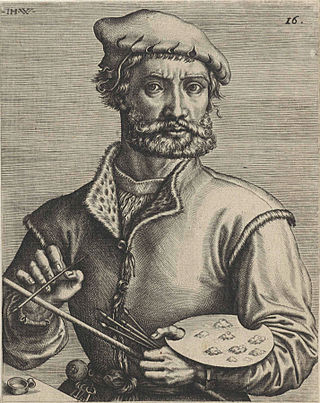
Pieter Coecke van Aelst or Pieter Coecke van Aelst the Elder was a Flemish painter, sculptor, architect, author and designer of woodcuts, goldsmith's work, stained glass and tapestries. His principal subjects were Christian religious themes. He hailed from the Duchy of Brabant, worked in Antwerp and Brussels, and was appointed court painter to Charles V, Holy Roman Emperor.

Flemish painting flourished from the early 15th century until the 17th century, gradually becoming distinct from the painting of the rest of the Low Countries, especially the modern Netherlands. In the early period, up to about 1520, the painting of the whole area is typically considered as a whole, as Early Netherlandish painting. This was dominated by the Flemish south, but painters from the north were also important. Dutch and Flemish Renaissance painting, of which Antwerp became the centre, covers the period up to about 1580 or later, by the end of which the north and south Netherlands had become politically separated. Flemish Baroque painting was especially important in the first half of the 17th century, dominated by Rubens.
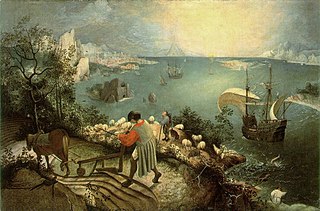
Dutch and Flemish Renaissance painting represents the 16th-century response to Italian Renaissance art in the Low Countries, as well as many continuities with the preceding Early Netherlandish painting. The period spans from the Antwerp Mannerists and Hieronymus Bosch at the start of the 16th century to the late Northern Mannerists such as Hendrik Goltzius and Joachim Wtewael at the end. Artists drew on both the recent innovations of Italian painting and the local traditions of the Early Netherlandish artists.
The Antwerp School was a school of artists active in Antwerp, first during the 16th century when the city was the economic center of the Low Countries, and then during the 17th century when it became the artistic stronghold of the Flemish Baroque under Peter Paul Rubens.

Maerten de Vos, Maerten de Vos the Elder or Marten de Vos was a Flemish painter. He is known mainly for his history and allegorical paintings and portraits. He was, together with the brothers Ambrosius Francken I and Frans Francken I, one of the leading history painters in the Spanish Netherlands after Frans Floris career slumped in the second half of the sixteenth century as a result of the Iconoclastic fury of the Beeldenstorm.

Flemish Baroque painting was a style of painting in the Southern Netherlands during Spanish control in the 16th and 17th centuries. The period roughly begins when the Dutch Republic was split from the Habsburg Spain regions to the south with the Spanish recapturing of Antwerp in 1585 and goes until about 1700, when Spanish Habsburg authority ended with the death of King Charles II. Antwerp, home to the prominent artists Peter Paul Rubens, Anthony van Dyck, and Jacob Jordaens, was the artistic nexus, while other notable cities include Brussels and Ghent.

The art of the Low Countries consists of painting, sculpture, architecture, printmaking, pottery, and other forms of visual art produced in the Low Countries, and since the 19th century in Belgium in the southern Netherlands and the Netherlands in the north.

Northern Mannerism is the form of Mannerism found in the visual arts north of the Alps in the 16th and early 17th centuries. Styles largely derived from Italian Mannerism were found in the Netherlands and elsewhere from around the mid-century, especially Mannerist ornament in architecture; this article concentrates on those times and places where Northern Mannerism generated its most original and distinctive work.
Despite its size, Belgium has a long and distinguished artistic tradition that goes back to the Middle Ages, considerably pre-dating the foundation of the current state in 1830. Art from the areas making up modern Belgium is called in English Netherlandish up to the separation with the Netherlands from 1570 on, and Flemish until the 18th century.

The world landscape, a translation of the German Weltlandschaft, is a type of composition in Western painting showing an imaginary panoramic landscape seen from an elevated viewpoint that includes mountains and lowlands, water, and buildings. The subject of each painting is usually a Biblical or historical narrative, but the figures comprising this narrative element are dwarfed by their surroundings.
The Golden Age of Flanders, or Flemish Golden Age, is a term that has been used to describe the flourishing of cultural and economic activities of the Low Countries around the 16th century. The term Flanders in the 16th century referred to the entire Habsburg Netherlands within the Burgundian Circle of the Holy Roman Empire. It was inclusive of modern-day Belgium, the Netherlands, and Luxembourg. Its political capital was Brussels, while the financial-economic centre was Antwerp. Other major artistic and cultural centres of the period included Bruges, Ghent, Mechelen and Leuven. It is also grouped with the Dutch Golden Age, a more common term used primarily in reference to the Dutch Republic, and typically dated from 1588 to 1672, within a "Flemish and Dutch golden age" covering the period from the late 15th to the 17th century.
